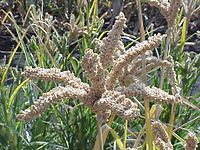
Photo from wikipedia
The past two decades of R & D for sorghum and millets in SSA have generated a wealth of new evidence. A synthesis of this evidence identified six strategic lessons.… Click to show full abstract
The past two decades of R & D for sorghum and millets in SSA have generated a wealth of new evidence. A synthesis of this evidence identified six strategic lessons. These were that demand is not being driven by ‘new uses’, that plant breeding programmes need to respond to African farmer's contexts and objectives to increase impact, that availability is a bigger constraint on the supply of certified seed than physical or economic access, that higher adoption of improved varieties does not generally result in higher yields, that technology and varietal diversity can compensate for climate change, and that commercialisation can be gender – and socially inclusive. R & D in Africa differs from the Indian model because of the low level of commercialisation and the continued dominance of own consumption. Consequently R & D gives a dominant role to the public sector in plant breeding, to farmer organisations and groups in seed supply, and to prioritising household food security over commercial uses.
Journal Title: Outlook on Agriculture
Year Published: 2022
Link to full text (if available)
Share on Social Media: Sign Up to like & get
recommendations!